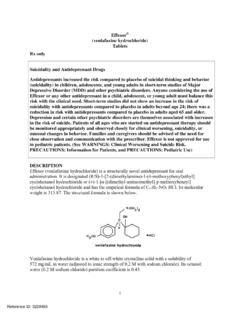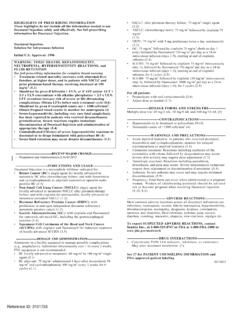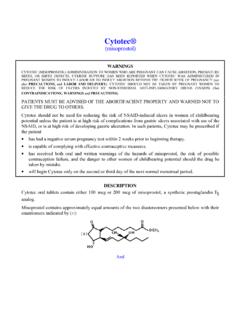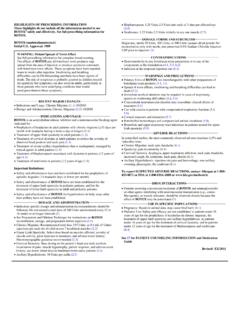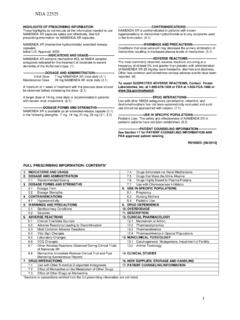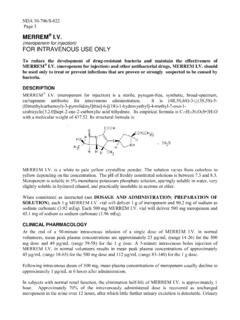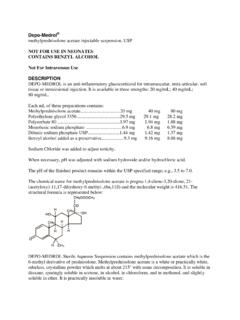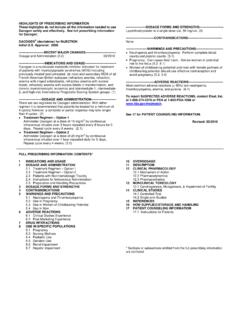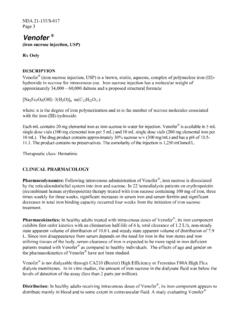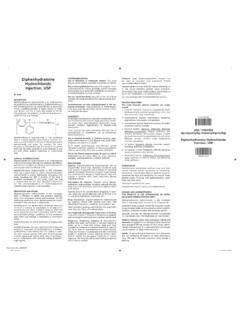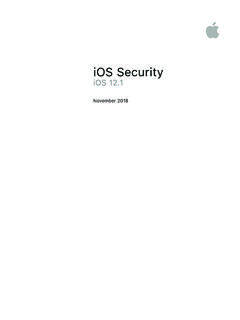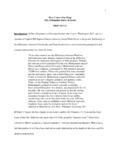Transcription of EPIDIOLEX (cannabidiol) oral solution
1 HIGHLIGHTS OF PRESCRIBING INFORMATION These highlights do not include all the information needed to use EPIDIOLEX safely and effectively.
2 See full prescribing information for EPIDIOLEX . EPIDIOLEX (cannabidi ol) oral solution , CX [pending DEA scheduling action] Initial Approval: XXXX [pending controlled substance scheduling] ------------ -- --- -- -- -- --- --INDICATIONS AND USAGE-------------------------- EPIDIOLEX is indicated for the treatment of seizures associated with Lennox-Gastaut syndrome or Dravet syndrome in patients 2 years of age and older (1) ------------ -- --- -- -- -DOSAGE AND ADMINIS TRATION---------------------- Obtain serum transaminases (ALT and AST) and total bilirubin levels in all patients prior to starting treatment. ( , ) EPIDIOLEX is to be administered orally.
3 ( ) The recommended starting dosage is mg/kg taken twice daily (5 mg/kg/day). After one week, the dosage can be increased to a maintenance dosage of 5 mg/kg twice daily (10 mg/kg/day). ( ) Based on individual clinical response and tolerability, EPIDIOLEX can be increasedup to a maximu m recommended maintenance dosage of 10 mg/kg twice daily (20 mg/kg/day). See Full Prescribing Information for titration. ( ) Dosage adjustment is recommended for patients with moderate or severe hepatic impairment. ( , ) ------------ -- --- -- --DOSAGE FORMS AND STRENGTHS --------------------- Oral solution : 100 mg/mL (3) ------------ -- --- -- -- -- --- -- -- -CONTRAINDICATIONS ----------------------------- Hypersensitivity to cannabidiol or any of the ingredients in EPIDIOLEX (4) ------------ -- --- -- -- --W ARNINGS AND PRECAUTIONS ----------------------- Hepatocellular Injury: EPIDIOLEX can cause transaminase elevations.
4 Concomitant use of valproate and higher doses of EPIDIOLEX increase the risk of transaminase elevations. See Full Prescribing Information for serum transaminase and bilirubin monitoring recommendations . ( ) Somnolence and Sedation: Monitor for somnolence and sedation and advise patients not to drive or operate machinery until they have gained sufficient experience on EPIDIOLEX . ( ) Suicidal Behavior and Ideation: Monitor patients for suicidal behavior and thoughts. ( ) Hypersenstivity Reactions: Advise patients to seek immediate medical care. Discontinue and do not restart EPIDIOLEX if hypersensitivity occurs. ( ) Withdrawal of Antiepileptic Drugs: EPIDIOLEX should be gradually withdrawn to minimize the risk of increased seizure frequency and status epilepticus.
5 ( ) ------------ -- --- -- -- -- --- -- --ADVERS E REACTIONS ------------------------------ The most common adverse reactions (10% or more for EPIDIOLEX and greater than placebo) are: somnolence; decreased appetite; diarrhea; transaminase elevations ; fatigue, malaise, and asthenia; rash; insomnia, sleep disorder, and poor quality sleep; and infections . ( ). To report SUSPECTED ADVERS E REACTIONS, contact Greenwich Biosciences at 1-833-424-6724 (1-833-GBIOSCI) or FDA at 1-800-FDA 1088 or me dwatch. -------------------------------DRUG INTERACTIONS ----------------------------- Moderate or strong inhibitors of CYP3A4 or CYP2C19: Consider dose reduction of EPIDIOLEX .
6 ( ) Strong inducer of CYP3A4 or CYP2C19: Consider dose increase of EPIDIOLEX . ( ) Consider a dose reduction of substrates of UGT1A9, UGT2B7, CYP2C8, CYP2C9, and CYP2C19 ( , clobazam). ( ) Substrates of CYP1A2 and CYP2B6 may also require dose adjustment . ( ) ------------ -- --- -- -- --US E IN SPECIFIC POPULATIONS ----------------------- Pregnancy: Based on animal data, may cause fetal harm. ( ) See 17 for PATIENT COUNSELING INFORMATION and Medication guide Revised: 6/2018 FULL PRESCRIBING INFORMATION: CONTENTS* 1 INDICATIONS AND USAGE 2 DOSAGE AND ADMINISTRATION Assessments Prior to Initiating EPIDIOLEX Dosage Information Administration Instructions Discontinuation of EPIDIOLEX Patients with Hepatic Impairment 3 DOSAGE FORMS AND STRENGTHS 4 CONTRAINDICATIONS 5 WARNINGS AND PRECAUTIONS Hepatocellular Injury Somnolence and Sedation Suicidal Behavior and Ideation Hypersensitivity Reactions Withdrawal of Antiepileptic Drugs 6 ADVERS E REACTIONS Clinical Trials Experience 7 DRUG INTERACTIONS Effect of Other Drugs on EPIDIOLEX Effect of EPIDIOLEX on Other Drugs Concomitant Use of EPIDIOLEX and
7 Valproate CNS Depressants and Alcohol 8 USE IN SPECIFIC POPULATIONS Pregnancy Lactation Pediatric Use Geriatric Use Hepatic Impairment 9 DRUG ABUSE AND DEPENDENCE Controlled Subs tance Abuse Dependence 11 DESCRIPTION 12 CLINICAL PHARMACOLOGY Mechanism of Action Pharmacodynamics Pharmacokinetics 13 NONCLINICAL TOXICOLOGY Carcinogenesis and Mutagenesis 14 CLINICAL STUDIES Lennox-Gastaut Syndrome Dravet Syndrome 16 HOW SUPPLIED/STORAGE AND HANDLING How Supplied Storage and Handling 17 PATIENT COUNSELING INFORMATION * Sections or subsections omitted from the full prescribing information are not listed. Reference ID: 4282447 FULL PRESCRIBING INFORMATION 1 INDICATIONS AND USAGE EPIDIOLEX is indicated for the treatment of seizures associated with Lennox-Gastaut syndrome (LGS) or Dravet syndrome (DS) in patients 2 years of age and older.
8 2 DOSAGE AND ADMINISTRATION Assessments Prior to Initiating EPIDIOLEX Because of the risk of hepatocellular injury, obtain serum transaminases (ALT and AST) and total bilirubin levels in all patients prior to starting treatment with EPIDIOLEX [see Warnings and Precautions ( )]. Dosage Information EPIDIOLEX is to be administered orally. The starting dosage is mg/kg twice daily (5 mg/kg/day). After one week, the dosage can be increased to a maintenance dosage of 5 mg/kg twice daily (10 mg/kg/day). Patients who are tolerating EPIDIOLEX at 5 mg/kg twice daily and require further reduction of seizures may benefit from a dosage increase up to a maximum recommended maintenance dosage of 10 mg/kg twice daily (20 mg/kg/day), in weekly increments of mg/kg twice daily (5 mg/kg/day), as tolerated.
9 For patients in whom a more rapid titration from 10 mg/kg/day to 20 mg/kg/day is warranted, the dosage may be increased no more frequently than every other day. Administration of the 20 mg/kg/day dosage resulted in somewhat greater reductions in seizure rates than the recommended maintenance dosage of 10 mg/kg/day, but with an increase in adverse reactions. Administration Instructions Food may affect EPIDIOLEX levels [see Clinical Pharmacology ( )] . A calibrated measuring device (either 5 mL or 1 mL oral syringe) will be provided and is recommended to measure and deliver the prescribed dose accurately [see How Supplied/Storage and Handling ( )].
10 A household teaspoon or tablespoon is not an adequate measuring device. Discard any unused EPIDIOLEX remaining 12 weeks after first opening the bottle [see How Supplied/ Storage and Handling ( )]. Discontinuation of EPIDIOLEX When discontinuing EPIDIOLEX , the dose should be decreased gradually. As with all antiepileptic drugs, abrupt discontinuation should be avoided when possible, to minimize the risk of increased seizure frequency and status epilepticus [see Warnings and Precautions ( )]. Patients with Hepatic Impairment Dose adjustment is recommended in patients with moderate (Child-Pugh B) hepatic impairment or severe (Child-Pugh C) hepatic impairment [see Warnings and Precautions ( ), Use in Specific Populations ( ), Reference ID: 4282447 and Clinical Pharmacology ( )].
